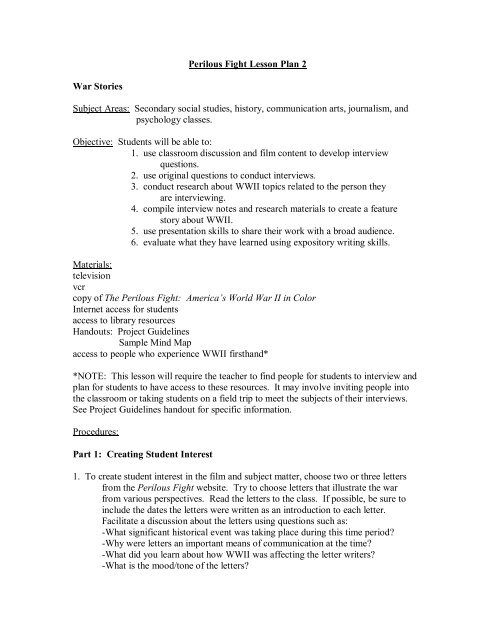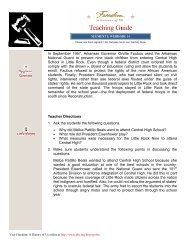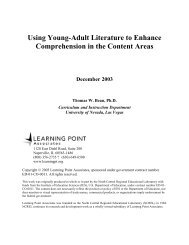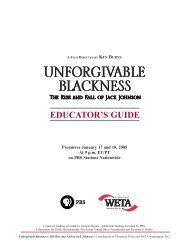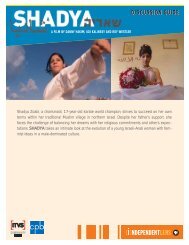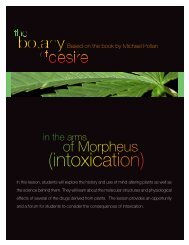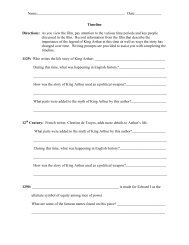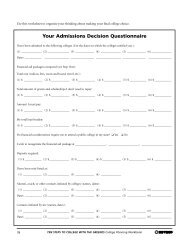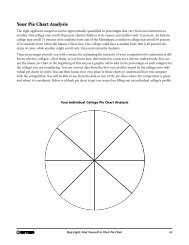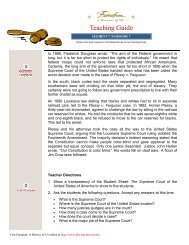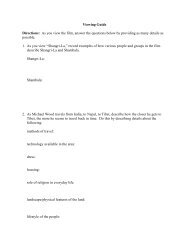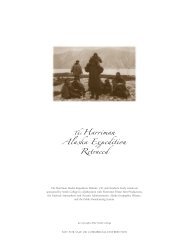Perilous Fight Lesson Plan 2 War Stories Subject Areas ... - PBS
Perilous Fight Lesson Plan 2 War Stories Subject Areas ... - PBS
Perilous Fight Lesson Plan 2 War Stories Subject Areas ... - PBS
You also want an ePaper? Increase the reach of your titles
YUMPU automatically turns print PDFs into web optimized ePapers that Google loves.
<strong>Perilous</strong> <strong>Fight</strong> <strong>Lesson</strong> <strong>Plan</strong> 2<br />
<strong>War</strong> <strong>Stories</strong><br />
<strong>Subject</strong> <strong>Areas</strong>: Secondary social studies, history, communication arts, journalism, and<br />
psychology classes.<br />
Objective: Students will be able to:<br />
1. use classroom discussion and film content to develop interview<br />
questions.<br />
2. use original questions to conduct interviews.<br />
3. conduct research about WWII topics related to the person they<br />
are interviewing.<br />
4. compile interview notes and research materials to create a feature<br />
story about WWII.<br />
5. use presentation skills to share their work with a broad audience.<br />
6. evaluate what they have learned using expository writing skills.<br />
Materials:<br />
television<br />
vcr<br />
copy of The <strong>Perilous</strong> <strong>Fight</strong>: America’s World <strong>War</strong> II in Color<br />
Internet access for students<br />
access to library resources<br />
Handouts: Project Guidelines<br />
Sample Mind Map<br />
access to people who experience WWII firsthand*<br />
*NOTE: This lesson will require the teacher to find people for students to interview and<br />
plan for students to have access to these resources. It may involve inviting people into<br />
the classroom or taking students on a field trip to meet the subjects of their interviews.<br />
See Project Guidelines handout for specific information.<br />
Procedures:<br />
Part 1: Creating Student Interest<br />
1. To create student interest in the film and subject matter, choose two or three letters<br />
from the <strong>Perilous</strong> <strong>Fight</strong> website. Try to choose letters that illustrate the war<br />
from various perspectives. Read the letters to the class. If possible, be sure to<br />
include the dates the letters were written as an introduction to each letter.<br />
Facilitate a discussion about the letters using questions such as:<br />
-What significant historical event was taking place during this time period?<br />
-Why were letters an important means of communication at the time?<br />
-What did you learn about how WWII was affecting the letter writers?<br />
-What is the mood/tone of the letters?
2. After discussing the letters briefly, give students 3-5 minutes to brainstorm about<br />
what they already know about WWII. Ask them to record words and phrases<br />
related to WWII on paper. Remind students this is an individual, silent activity.<br />
3. When students finish individual brainstorming, take time to create a graphic organizer<br />
similar to the sample Mind Map that is included with the plan. Use information<br />
from student brainstorming to complete each section of the Mind Map. Post this<br />
Mind Map where all students can refer to it. (NOTE: Use poster board or butcher<br />
paper to create this large Mind Map so it is easy for all students to read.)<br />
4. Introduce the film by telling students they will be seeing a color history of actual<br />
WWII footage while learning about the war through a number of letters that<br />
were exchanged between families and friends throughout the war. Encourage<br />
students to focus on the important role the letters played in terms of<br />
communication between families as well as for boosting the morale of both<br />
troops and the U.S. citizens on the home front.<br />
5. Show the following segments of the film:<br />
Introduction/film opening<br />
Part 1: 38:40 to 44:30 Pearl Harbor<br />
50:26 to end Midway<br />
Part 2: Beginning to 9:21 Army life, role of women, internment<br />
20:50 to22:18 Psychological effects<br />
23:30 to 26:25 Life on the Home Front<br />
36:15 to 44:17 Women in the workforce, military, and WASP’s, German<br />
war atrocities<br />
Part 3: Beginning to 10:55 Dday planning and invasion<br />
14:45 to 18:25 One family’s story, Italian front<br />
28:45 to 31:15 One family’s story<br />
34:18 to 35:36 Concentration camps<br />
36:12 to 37:54 Concentration camps<br />
39: 40 to 41:05 VE Day<br />
Part 4: Beginning to 10:00 Pacific front, life at home, psychological effects<br />
11:40 to 12:25 Saipan<br />
22:40 to 23:50 Importance of letters<br />
28:15 to 29:15 Importance of letters<br />
34:50 to 36:20 One family’s story<br />
37:50 to end of film Final victory<br />
Part 2: Learning from the Past<br />
NOTE: This portion of the lesson will require the teacher to find people for students to<br />
interview and plan for students to have access to these resources. It may involve inviting<br />
people into the classroom or taking students on a field trip to meet the subjects of their<br />
interviews.
1. Once students have viewed film segments, discuss which segments/letters had<br />
the greatest effect on the students as viewers. Do this using questions such as:<br />
-What did you learn about WWII that you didn’t know before?<br />
-How did hearing the letters make you feel about what people endured during<br />
WWII?<br />
-Did hearing the letters effect any of the opinions you have about the current<br />
conflicts the U.S. is facing today?<br />
-How do you think you would have reacted if you were in the situations that<br />
were described in the letters?<br />
2. When discussion is completed, introduce students to the project. Explain to them<br />
that they will be using what they have learned from the film to help them<br />
further investigate and report on WWII. Explain to students that they will need<br />
to conduct interviews about different aspects of the war from reliable sources.<br />
Not only will they research, but they must create a project that shows what they<br />
have learned. The project should be done according to the directions on the<br />
Project Guidelines sheet included with the lesson plan.<br />
3. Give students ample time to plan, conduct interviews and research, write and edit their<br />
stories, and prepare them for presentation.<br />
Part 3: Sharing Your Work<br />
1. Once stories have been completed, have students share their work with the class.<br />
Teachers can decide how this should be done. Consider having students placed<br />
in small groups so they can hear 3-4 other stories, having students read stories<br />
individually to the entire class, or distributing stories to the entire class by<br />
compiling them and producing a sort of book that all students can have a copy of.<br />
2. As a follow-up to the assignment, ask students to write a 1-2 paragraph response to<br />
the lesson. Have them address questions such as:<br />
-What did you learn from this assignment?<br />
-In what ways did this assignment change or affect you?<br />
-Did hearing stories based on the experiences of real people make the topic<br />
more relevant and real for you? Why?<br />
-How did what you learned from this assignment effect how you feel about<br />
America’s involvement and handling of current world conflicts?<br />
Assessment Suggestions:<br />
1. Give students a participation grade for taking part in brainstorming activities<br />
and discussions.<br />
2. Create a checklist or scoring guide to evaluate the quality of the feature stories written<br />
by each student. This could then be used to assign a grade for the project
3. Create a peer evaluation form that will allow students to critique one another’s final<br />
projects.<br />
4. Give students a completion grade for doing the follow-up written response to the<br />
assignment.<br />
Extension Activities:<br />
1. Invite the group of people who were interviewed into the classroom to hear students<br />
share their stories. After stories have been shared, allow for open discussion time<br />
between students and the older adults they interviewed. This will allow students<br />
to learn more about the experiences of those who lived through WWII and will<br />
offer those who were interviewed the opportunity to share their experiences<br />
directly with more students.<br />
2. Compile the stories into a book that could be distributed to other classrooms in the<br />
school, district, or area who are studying WWII. Encourage students and teachers<br />
to use it as a tool for learning more about what people truly endured and how they<br />
were affected by their experiences.<br />
3. Have students spend additional time gathering pictures and video clips related to their<br />
stories. Using presentation software such as Power Point, have students use the<br />
pictures, video clips, and music to create a multimedia presentation related to their<br />
story. They could then have this presentation running as they read their feature<br />
story. This will add a technology and visual component to the assignment.<br />
National Standards:<br />
Historical Understanding<br />
Standard 2: Understands the historical perspective<br />
United States History<br />
Standard 25: Understands the causes and course of World <strong>War</strong> II, the character of the<br />
war at home and abroad, and its reshaping of the U.S. role in world affairs<br />
World History<br />
Standard 41: Understands the causes and global consequences of World <strong>War</strong> II<br />
Language Arts:<br />
Writing<br />
Standard 2: Uses stylistic and rhetorical aspects of writing<br />
Standard 4: Gathers and uses information for research purposes<br />
Reading
Standard 7: Uses reading skills and strategies to understand and interpret a variety of<br />
informational texts<br />
Listening and Speaking<br />
Standard 8: Uses listening and speaking strategies for different purposes<br />
Viewing<br />
Standard 9: Uses viewing skills and strategies to understand and interpret visual media<br />
Behavioral Studies<br />
Standard 4: Understands conflict, cooperation, and interdependence among individuals,<br />
groups, and institutions<br />
About the Author: Lisa Prososki is an independent educational consultant who taught<br />
middle school and high school social studies, English, reading, and technology courses<br />
for twelve years. Prososki has worked with <strong>PBS</strong> TeacherSource and has authored many<br />
lesson plans for various <strong>PBS</strong> programs over the past five years. In addition to developing<br />
materials for corporate clients and conducting workshops for teachers at various state and<br />
national conventions, Prososki has also worked as an editor and authored one book.
The <strong>Perilous</strong> <strong>Fight</strong> <strong>Lesson</strong> <strong>Plan</strong>: Project Guidelines<br />
Name:____________________________________ Date:_________________________<br />
Directions: You will be working to create a project that describes what you have learned<br />
about WWII through investigative interviewing and research. It is important that you<br />
follow the criteria below when planning the project.<br />
Project Goal: To create a project that can be used to teach others about WWII through<br />
personal accounts of what happened and how people were affected by<br />
the events.<br />
Project Expectations:<br />
Start your project by interviewing people who actually experienced WWII first hand.<br />
These people could be contacted through phoning local veteran’s groups such as VFW or<br />
American Legion posts, local senior citizens centers, veteran’s hospitals, or other related<br />
organizations. It is important to remember to interview a variety of people such as<br />
former soldiers, women, minorities, volunteers, or people who had family members<br />
directly involved in the war effort in some way. Think about people from your own<br />
family who may be able to offer information about life during WWII.<br />
After you have conducted your interviews, create feature articles that tell their stories.<br />
Include photographs if they are relevant. Remember to use a headline and byline for each<br />
story, captions for the pictures, and as many quotes as possible to make your stories<br />
interesting.<br />
Your last step will be to compile the feature articles into a short newsletter or magazine<br />
type of format. This will allow others to read your work easily and clearly.<br />
<strong>Plan</strong>ning:<br />
It is important to develop interview questions BEFORE going to conduct your interviews.<br />
On a separate sheet of paper, construct at least 20 questions related to WWII. Use the<br />
Mind Map created by your class to help you think of questions that span a variety of<br />
subjects related to the war. If you know the person you will be interviewing, tailor your<br />
questions to them. (i.e. Ask former soldiers about military life, training, battles,<br />
experiences. Ask a woman who was left at home to care for children and work outside<br />
the home about things related to her work, her children, and the feelings she had about<br />
how her life had changed.) Be sure to get specific facts about who, what, when, where,<br />
why, and how when you conduct your interviews.<br />
Doing the Interview:<br />
Interviewing is tricky business. It requires one to listen, write, and think about the<br />
information all at once. This can be difficult. If you can an inexperienced interviewer,
you might consider asking the person you are interviewing if you can make an audio or<br />
video tape of the interview so you can refer to it later. If this is not possible, take your<br />
time while interviewing, checking for accuracy frequently as you take notes. Don’t be<br />
afraid to ask people to repeat themselves. Finally, if the person being interviewed has<br />
letters or excerpts from letters they would be willing to share, try to get copies of these so<br />
they can be included in the articles.<br />
Using the Information:<br />
After you have completed your interview, go to work writing your story. As you do this,<br />
you may find that you need to conduct ADDITIONAL RESEARCH. For example, if the<br />
person you interviewed talks about life in an internment camp or being involved in a<br />
specific battle or conflict, you will want to learn more about that so you can accurately<br />
portray it as you write your article. This would also be a good time to gather relevant<br />
pictures to accompany the story. Use the <strong>Perilous</strong> <strong>Fight</strong> website along with other<br />
Internet resources and library materials to learn about key events, people, places, and<br />
things. Pay particular attention to the timeline and subcategories that can be searched at<br />
the <strong>Perilous</strong> <strong>Fight</strong> website.<br />
As you write your articles, be sure to give readers the historical background they need to<br />
understand how the person being interviewed experienced WWII. In addition to focusing<br />
on facts, spend time talking about the short and long term effects the war had on the<br />
person being interviewed. If possible, see how these experiences shape their feelings<br />
about the conflicts America is currently facing throughout the world. Finally, if you have<br />
received letters or excerpts to use, make them part of the story, not just something that is<br />
included because you had access to it.<br />
Articles should be typewritten and should be at least one page in length. In addition,<br />
pictures should be used whenever possible to help illustrate what the story is about.<br />
Make two copies of your stories so you can give one to the people that were interviewed.<br />
Sharing Your Work:<br />
Be prepared to share your work with the people you interviewed, your classmates, and<br />
others interested in learning about WWII. You may be asked to do this by reading your<br />
article aloud or by allowing others to read it.
The <strong>Perilous</strong> <strong>Fight</strong> <strong>Lesson</strong> <strong>Plan</strong>: Mind Map Sample<br />
To Use: The four main themes of the film/website are listed below in the outer circles.<br />
Students should be encouraged to place their brainstorming ideas around the outer edge<br />
of the circle that it is best applied to. See The Psychology of <strong>War</strong> circle for examples.<br />
Under each example (i.e. <strong>War</strong> Atrocities) additional detail lines could be added (i.e.<br />
POW camps, concentration camps, etc.) Use as much detail as possible to create a full<br />
web of information.<br />
The<br />
Battlefields<br />
Social<br />
Aspects<br />
World <strong>War</strong><br />
II<br />
The Home<br />
Front<br />
<strong>War</strong> Atrocities<br />
The Kamikaze’s<br />
The<br />
Psychology<br />
of <strong>War</strong><br />
The Atomic Bomb<br />
Mental toll


